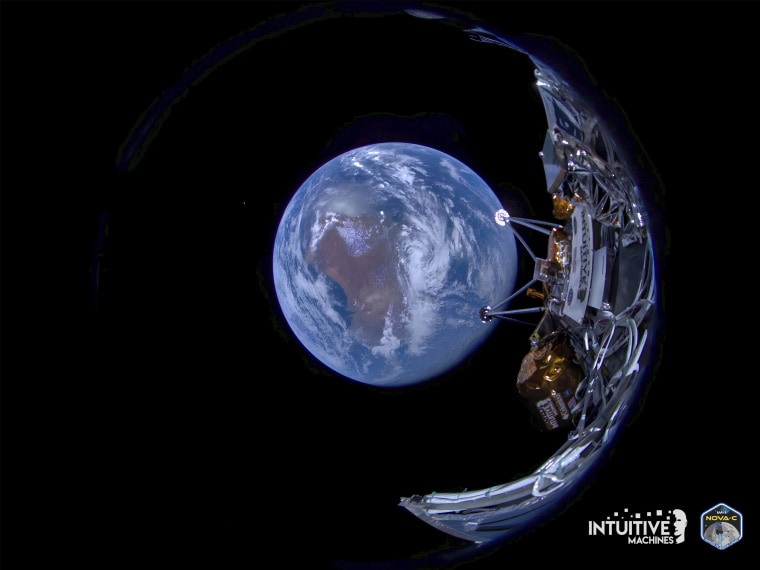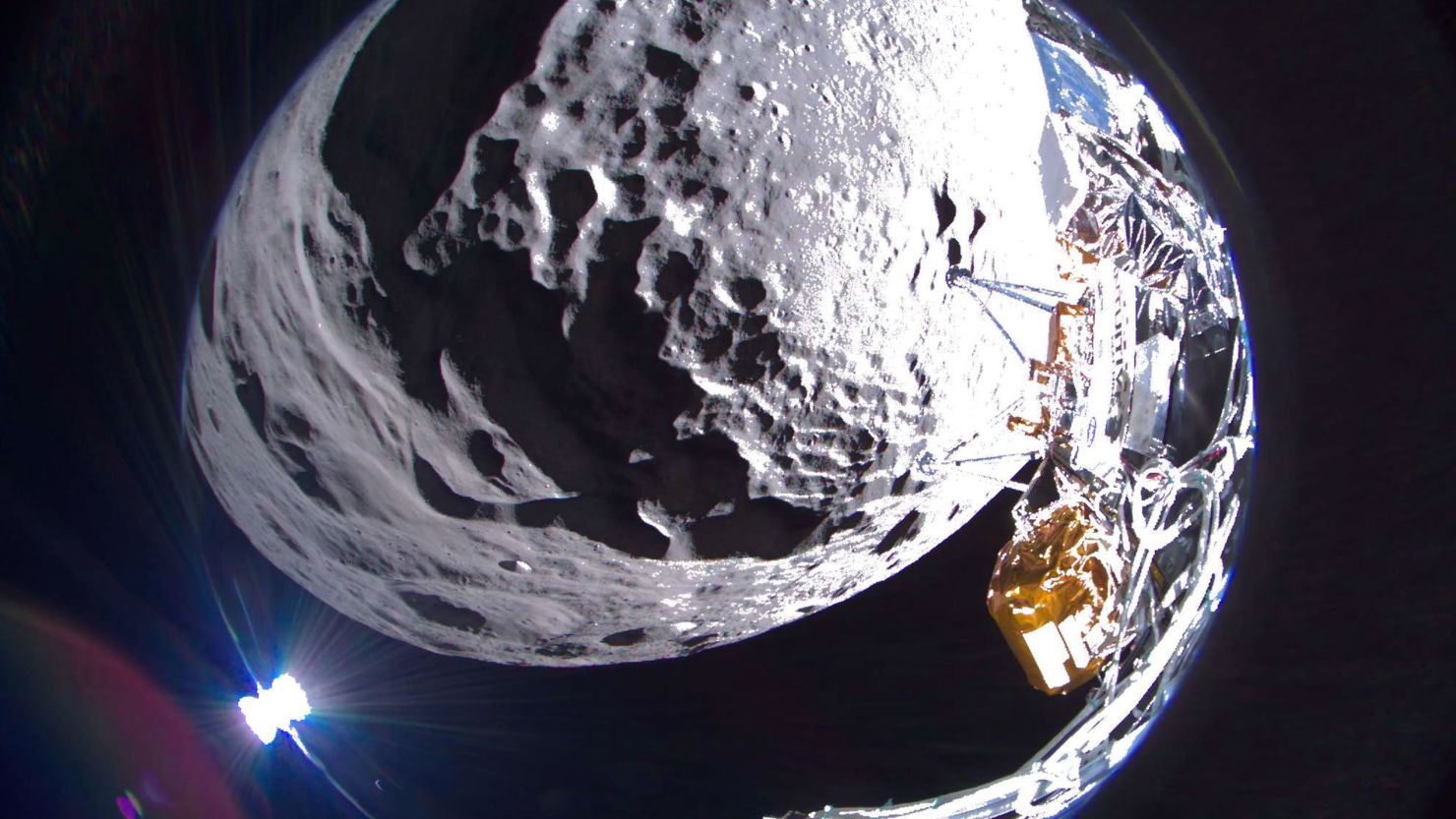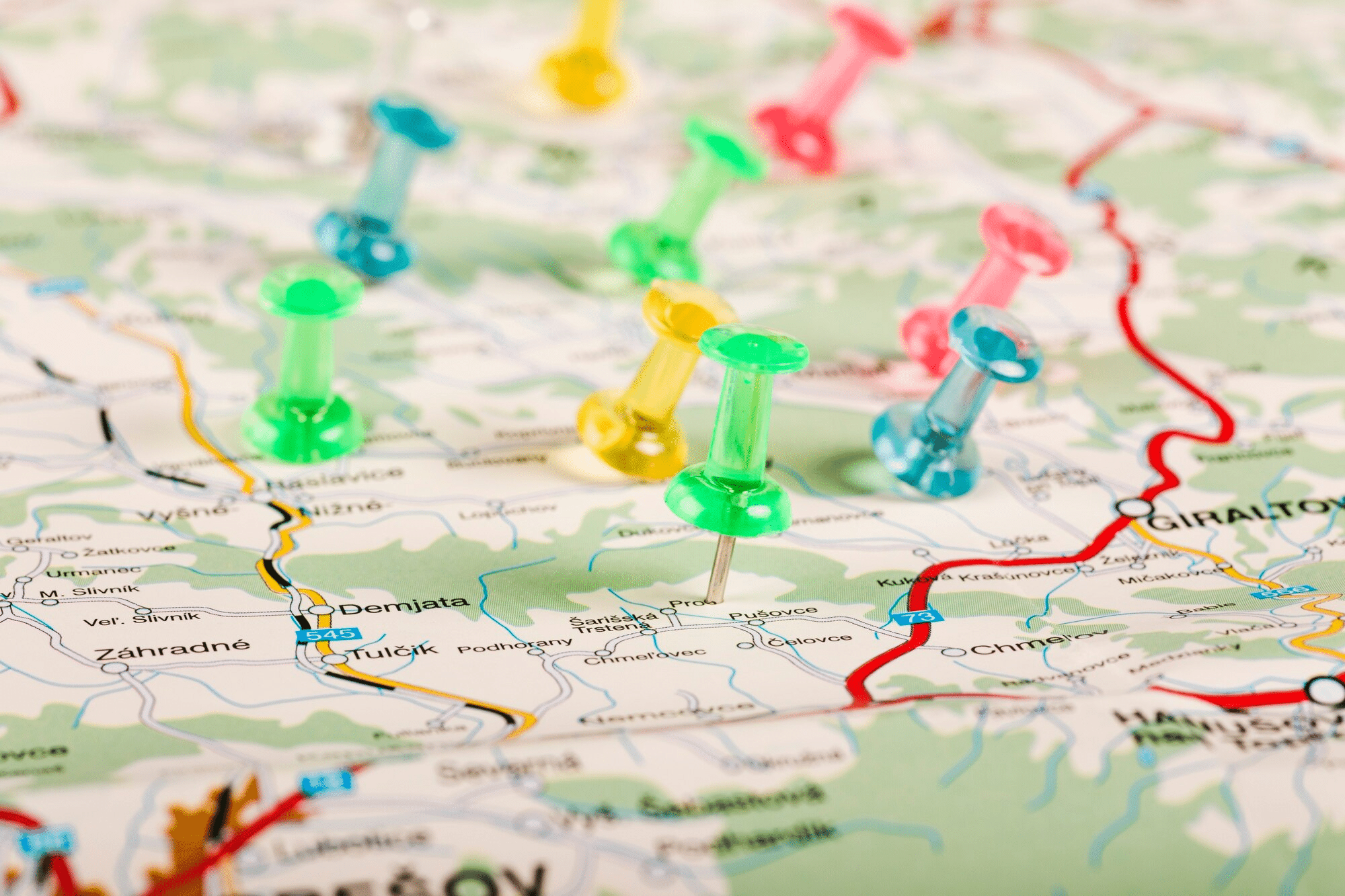Tech
Sideways Moon Landing Cuts Mission Short, Private US Lunar Lander Will Stop Working Tuesday

CAPE CANAVERAL, Florida – A private US lunar lander’s mission was cut short after landing sideways near the moon’s south pole. It is likely to stop operational on Tuesday.
Intuitive Machines, the Houston-based firm that developed and flew the spacecraft, announced Monday that it will continue to collect data until the solar panels no longer receive sunlight. Officials estimate this to happen early Tuesday, based on the Earth’s and moon’s positions. That falls two to three days short of the week that NASA and other clients had anticipated.
The lander, dubbed Odysseus, is the first U.S. spacecraft to land on the moon in over 50 years, carrying experiments for NASA, the primary sponsor. However, it arrived too quickly last Thursday, and the foot of one of its six legs caught on the surface, forcing it to tip over, according to company authorities.
According to photographs taken by NASA’s lunar reconnaissance orbiter, Odysseus landed within a mile (1.5 kilometres) of its planned target at the Malapert A crater, roughly 185 miles (300 kilometres) from the moon’s south pole.
The LRO shots from 56 miles (90 km) above show the lander on the surface, but it is hardly visible in the blurry images. Embry-Riddle Aeronautical University’s camera-ejecting experiment, which was supposed to record photographs of the lander as they both dropped, was called off shortly before touchdown due to a last-minute navigation difficulty.
Sideways Moon Landing Cuts Mission Short, Private US Lunar Lander Will Stop Working Tuesday
According to NASA, the lander landed in a small, deteriorated crater with a 12-degree slope. That is the closest a spacecraft has ever gotten near the south pole, which is important due to probably frozen water in the permanently shadowed craters.
NASA, which intends to land astronauts in this region in the coming years, paid Intuitive Machines $118 million to bring six experiments to the surface. Other customers had things on board.
Sideways Moon Landing Cuts Mission Short, Private US Lunar Lander Will Stop Working Tuesday
Instead of landing upright, the 14-foot (4.3-meter) Odysseus landed on its side, limiting its connection with Earth. The overturned lander covered up some antennas, and those that remained exposed ended up near the ground, resulting in intermittent communications. The solar panels were much closer to the surface than expected, which was less than optimal given the mountainous terrain. Even in the best circumstances, Odysseus only had a week to function on the surface before the long lunar night began.
Since the 1960s, only the United States, Russia, China, India, and Japan have successfully landed on the moon, with the United States being the only one with crews. Japan’s lander also ended up on the wrong side last month.
Despite its tilted landing, Intuitive Machines was the first private company to join the privileged group. Another American company, Astrobotic Technology, attempted it last month but could not reach the moon due to a fuel leak.
Sideways Moon Landing Cuts Mission Short, Private US Lunar Lander Will Stop Working Tuesday
Intuitive Machines almost failed as well. Ground teams only activated the lander’s navigational lasers after its launch from Florida on February 15. The mistake was noticed when Odysseus circled the moon, forcing flight controllers to rely on a NASA laser-navigating gadget only on board as an experiment.
As it turned out, NASA’s test lasers guided Odysseus to a nearly perfect landing, marking the first moon landing by a U.S. spacecraft since the Apollo programme.
Twelve Apollo astronauts walked on the moon from 1969 to 1972. While NASA occasionally sent satellites around the moon, the United States launched another moon-landing mission this month. Astrobotic’s aborted voyage was the first in NASA’s programme to promote commercial lunar delivery.
Both Intuitive Machines and Astrobotics have NASA contracts for additional lunar landings.
SOURCE – (AP)
Tech
NVIDIA’s Earnings: The Leader In AI Chips Demonstrates Relentless Growth.

(VOR News) – Nvidia, the world’s most valuable company and a catalyst of the artificial intelligence revolution, announced another quarterly report on Wednesday, much to the delight of investors.
The company’s value has risen by $2.2 trillion this year to reach $3.6 trillion, attributed to a neardoubling of chip sales. It reported revenue of $35.08 billion, which fell short of the anticipated $33.15 billion. Year on year, its profits more than doubled. Revenue rose 94% compared to the same quarter of the prior year.
Nvidia predicted 70% revenue growth in the quarter.
Nvidia reported earnings of $0.81 per share, exceeding analysts’ predictions by $0.81. After the announcement, Nvidia’s stock plummeted over 5% in extended trading but immediately recovered to stay at a comparable level; it had previously closed at $145.89 in New York.
In a press statement last week, Nvidia CEO Jensen Huang projected that the computational power facilitating generative AI development will increase by “a millionfold” over the next decade.
Huang asserted during an earnings call that the extensive adoption of Nvidia technology is instigating a platform transition from coding to machine learning, prompting the reconfiguration of traditional data centers to facilitate artificial intelligence development.
A novel industrial revolution poised to create an artificial intelligence sector valued in the multi-trillion dollar range. Generative artificial intelligence is a new industry with artificial intelligence factories manufacturing digital intelligence, not merely a new tool capacity,” he stated.
“AI is revolutionizing every industry, organization, and country,” stated Huang. “Constructing an artificially generated data omniverse… the epoch of robotics has commenced.”
The robust demand for NVIDIA’s Blackwell GPU chips appears to have mitigated concerns regarding a potential decline in the company’s demand, as major digital corporations invest billions in data centers and artificial intelligence processing.
From an August low, Nvidia’s valuation has climbed 45%.
Subsequent to the election, the semiconductor stock has attained unprecedented peaks, increasing almost 200% this year and exceeding 1,100% over the past two years.
Nevertheless, as they struggle to compete with Nvidia’s supremacy in AI, other chip manufacturers have become a net detriment to the industry.
Wedbush analyst Dan Ives anticipated another “drop-the-mic performance” from Nvidia before the results were announced, asserting that the business was “the sole contender with over $1 trillion in AI capital expenditure forthcoming over the next few years, with Nvidia’s GPUs representing the new oil and gold in this domain.”
Recently, top global IT companies spent billions on AI.
Nvidia is perceived by many as a barometer for the technology sector and the desire for artificial intelligence, which has driven Wall Street to numerous all-time highs this year.
Markets are anxious due to the escalation of the Russia-Ukraine conflict, the likelihood that the Federal Reserve will not reduce US interest rates, and the potential for global tariff increases under Donald Trump’s forthcoming administration.
Ives’ assertion that Nvidia’s forthcoming Blackwell processor might propel the company’s revenues and market capitalization to historic levels was corroborated by multiple analysts. Indicators of “extraordinary demand” for the new chip, including forecasts of unprecedented sales and accounts of depleted inventories for the forthcoming year, are significant indicators of Nvidia’s continued exceptional growth, as stated by Saxo chief investment analyst Charu Chanana.
Nevertheless, due to its inflated valuation, Chanana warned that “any indications of production delays or insufficient demand could exert pressure on the stock.”
This week, a source reported that the chipmaker is seeing server overheating issues with its latest graphics processors, the B200 and GB200 NVL72, named after renowned American statistician and mathematician David Harold Blackwell.
Nvidia’s spokesperson remarked that “the engineering iterations are standard and anticipated,” without explicitly dismissing the report.
“Minor details can disrupt significant investments consistently,” stated computer magnate Michael Dell.
SOURCE: TG
SEE ALSO:
The Impact of Tier Regions on Digital Advertising ROI
The Game Awards 2024: How to Watch
Tech
How to Boost Your Instagram Live Videos

Video marketing on Instagram is booming. Today, developers offer influencers and entrepreneurs many tools to make their pages popular and improve their online credibility and visibility.
Streams are one of the most effective ways to communicate with the audience, expand reach and improve engagement. However, as with everything else, you should clearly understand what results you expect from this type of PR and what tools will help you achieve them.
Of course, the competition here is high and intense, so you should know the best ways to promote your live sessions and improve their visibility to stay ahead of the competition and make your streams better and viewed every day. You need to know several secrets to achieve the desired result here, and today, we’ll tell you about them. Keep reading!
Use paid Instagram service.
So, your goal is to get as many views as possible and attract more loyal fans. How can you do this? Generally speaking, there are many ways, but they all require a lot of effort, time and resources from you. Most of them are created for long-term PR; you’ll get the result from free methods only after a few weeks or months.
The best thing is that you can greatly simplify your growth and instantly get as many interactions as you want. The secret is simple. Today, professional advertising companies offer various boosts for rapid growth, including the opportunity to buy Instagram live video views.
You can check out Viplikes: https://viplikes.net/buy-instagram-live-video-views. In other words, real people will come to your stream and stay here for a while. Such a purchase will inevitably attract more new target subs – your live session will occupy a leading position in their feed. So, if you don’t have time to promote live videos in freeways or want to support your content, use a paid boost and combine it with other secrets of success, which we’ll share below.
Notify your followers and post teasers.
Yes, it’s normal if you start a stream without any notifications for your subscribers, but in this case, you should keep in mind that there will be much fewer interactions than you would like. That’s why SMM specialists and famous content makers recommend notifying fans in advance and writing the live session’s time, date and topic. Agree this is logical; if people know about the upcoming live video, they are more likely to visit it. So, if you aim to build up a large viewing base, keep this rule in mind and notify subscribers using Stories, Reels, posts or something else.
It’s the same with teasers: spread as much information as possible about the upcoming stream. Promise something unique and interesting that will be available only to live spectators. This is another secret of a successful session!
Collaborations
If you’ve never started streaming with another influencer, it’s time to do so! This is one of the best ways to quickly attract new spectators and improve live video statistics—a double benefit.
But you need to understand that not all bloggers agree to such activities, so it’s better to choose those with whom you’re already familiar or who have the same statistical indicators. Then, the effectiveness of the live sessions will be excellent, and the collaboration will go smoothly. Good luck!
Related News:
Turkey Instagram Ban Update!! Nationwide Blackout
Tech
The Impact of Tier Regions on Digital Advertising ROI

In today’s complex digital advertising world, knowing Tier regions is key. It is vital for getting the best ROI. Tier regions, also known as Tier 1, Tier 2, and Tier 3, refer to separate markets that may have different levels of economic development and different purchasing and media consumption patterns.
All markets raise prospects and issues that can affect ad success. This article reviews Tier regions and their impact on digital ad ROI, aiming to help marketers refine their strategies.
Understanding Tier Regions
- Tier 1 countries are generally developed economies with higher disposable income, such as the United States, Canada, and some Western European countries. These markets are usually characterized by high levels of advertisement clutter, that is, high competition, yet the population is accustomed to advertisements.
- Tier 2 regions are emerging markets like Brazil, India, and parts of Eastern Europe. These areas have relatively higher rates of economic growth and growing Internet usage, hence becoming the right place for advertisers. Yet they can also have disadvantages, including fluctuations in consumer behavior and less overall buying power compared to Tier 1 markets.
- Tier 3 regions generally encompass developing countries with slower economic growth, and digital infrastructure may still be in its infancy. Although these markets present long-term growth, the short-term effectiveness may be low owing to consumer purchasing capability and frequency of exposure to online advertisements.
Consumer Behaviour Concerning Organizational Setting
The behavior of the consumers in the different Tier regions is quite divergent. So, which Tier to choose? Tier 1 markets are usually more selective. They demand high quality and relevancy of the offered content.
They also prefer to interact with companies that have values that they hold dear, such as environmental conservation and corporate social responsibility values. This means that in these regions, the advertising companies may be forced to spend more time developing appealing messages to the target market.
In contrast, Tier 2 and Tier 3 consumers will likely follow the low involvement model, where the communication strategy consists of simple messages that focus on value and utility.
Advertisers targeting these regions should not concentrate on sales conversion but on branding to foster consumer trust. Marketing people who understand these differences in behaviors can help them adapt to them and gain much better ROI than they would expect.
Cost Considerations
The cost of advertisement is greatly influenced by the Tier regions, as illustrated in the figure below. Because of high competition, in Tier 2 and Tier 3 markets, there will be higher cost per click (CPC) and cost per impression (CPM).
This may, therefore, translate into higher initial costs, but it usually has the potential to give higher returns if the campaigns are managed appropriately.
Tier 2 and Tier 3 locations have lower GDP per capita, so advertising costs less there. This will attract brands with limited budgets.
However, marketers need to be wary; the latter is not necessarily always true, meaning that it is not rare to see lower costs entail lower ROI. The success of these campaigns can depend on audience activity and brand familiarity in different regions.
Measuring Success
Therefore, it is important to set success metrics, especially when comparing the ROI of Tier regions. Traditional measures, such as conversion rates and customer acquisition costs, may work better in Tier 1 markets.
In Tier 2 and Tier 3 cities, the end action value may better define success. Depending on the segmentation and targeting strategies, metrics like brand awareness or engagement might work, too.
For instance, tracking such factors as interactions on social networks or website attendance can significantly determine how successfully the campaign reflects the interests of the target audience in these regions.
The Tier region analysis of the current success metrics can be seen through the following perspective: marketers need to set up detailed success metrics depending on the attributes of every Tier region, which can provide a closer look at the campaign results.
Future Trends
Knowing new trends in digital ads in Tier regions will be key to getting high returns in the future. For example, mobile-first ads suit Tier 2 and 3 markets. These markets have the most active online users of mobile devices. Mobile campaign companies could reach many consumers and boost engagement.
Further, improved data analysis methods and artificial intelligence are helping advertisers better decide where to spend their money across Tier regions. These technologies allow marketers to fine-tune their campaigns over the traffic flow to maximize every strategy implemented for the best returns on investment.
Conclusion
The importance of Tier areas for digital advertising ROI cannot be underscored. Marketers may create more successful tactics for their target audiences by knowing the distinct features of each Tier, such as customer behavior, cost considerations, and success indicators.
As we approach 2024 and beyond, staying on top of area trends will be critical for optimizing advertising results. Those who adapt will succeed in today’s international digital marketplace.
Related News:
WELL Health Receives Permission for $44 Million Digital Initiative
WELL Health Receives Permission for $44 Million Digital Initiative
-
Tech4 weeks ago
Apple Unveiled A Fresh Glimpse Of Their AI Featuring ChatGPT Integration.
-
Business4 weeks ago
Costco Is Offering The Peloton Bike+ At 300 Locations This Holiday Season.
-
News4 weeks ago
Boeing Reports $6 Billion Quarterly Loss As Striking Workers Vote Whether To Accept Contract Offer
-
News4 weeks ago
The FBI Looks At Claimed Leaks Of Sensitive Israel Attack Records.
-
News4 weeks ago
‘Malcolm In The Middle’ Star Frankie Muniz Lands Full-Time NASCAR Ride In 2025
-
Business4 weeks ago
The Volkswagen China CMO Faced Expulsion From China Due To Drug Use.



























